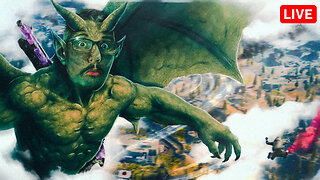Premium Only Content

5 Extinct Animals That May Still Exist
5 Extinct Animals That May Still Exist
Hey everyone, I'm mike chen and this is beyond science.
Did you like jurassic park? I watched it 8 time in theaters...no joke.
A little segway, do you remember when you used to watch a movie a bunch of times in theaters? Do people still do that? I mean if i really like a movie now I will watch it maybe twice in theater, I could NEVER spend the money and watch something in theaters 7 or 8 times, maybe because movies cost more now? I don't know...anyway lets get on track here.
I LOVED jurassic park because I love dinosaurs, or I should say I like anything interesting that I have never seen before. For example, when I heard the term extint animals I automatically think about the dodo bird, I like dodo birds, mainly cause I think their name sounds funny, i mean... dodo haha...
and if they had the dodo bird at the zoo I would for Sure go see it, now what if I told you that some of the animals that are believed to be extinct might actually not be? Here are five animals that are believed to be extinct that actually may still exist.
Number 1 the Thylacine
Thy la...what?
Thy la cine
the thylacine which is a tige/dog looking thing that was believed to be extinct in 1936. The Thylacine, also known as the Tasmanian Tiger, it means "the dog-headed pouched one" in Greek.
In late 2013, a team of british naturalists from the Centre for Fortean Zoology traveled into the wild terrains of Tasmania where the human population is near non-existent. Even though they haven't been able to capture any live footage of the animal with their camera traps, the researches are optimistic that some specimens still exists based on credible witnesses and theygathered sources of what could be the animal's feces for DNA analysis.
Number 2 is the Passenger Pigeon
haha...number 2
the passenger pigeon was once the most numerous bird on the planet during the 19th century until its extinction in the early 20th century due to hunting and loss of habitat.
Passenger pigeons are one species of extinct animals that could be resurrected by cloning. According to senior business editor Antonio Regalado of MIT Technology Review, the Long Now Foundation is financially supporting an effort known as Revive and Restore, to bring the passenger pigeons back to life...eh, anytime someone wants to bring something dead back to like i don't know, sounds like the beginning of every zombie movie. Cause you know what's worse than pigeons pooping on your head? zombie pigions pooping on your head.
It's also possible some passenger pigeons may still roam, according to reports by some bird watchers. However, none have been confirmed and the scientific consensus is that they are extinct
Number 3 the Honshu Wolf
The Japanese wolf, once occupied the islands of Honshu, Shikoku and Kyushu in Japan, was the world's smallest known wolf Its population began to decrease in 1732 when rabies was first reported in Kyushu and Shikoku.Though declared extinct in 1905, a photograph shows a specimen surviving until 1910.
the possibility that the Japanese wolf may still exist—given the number of cases of sightings, photos, and reports of carcasses from time to time.
Number 4 is a dinosaur called Mokele-mbembe meaning "one who stops the flow of rivers," The legendary creature is said to live deep in the Congo River basin of Central Africa and is thought by some cryptozoologists to be a Sauropod dinosaur.
William Gibbons, an explorer with a Ph.D. in Cultural Anthropology at Warnborough College, Oxford, has conducted expeditions deep into the Congo. Gibbons met Pastor Eugene P. Thomas who recounted that the pygmies, a local tribe situated near Lake Tele ended up killing one of the Mokele-Mbembes in 1959.
The last of the 5 is the Woolly Mammoth which lived alongside early humans around 200,000 years ago in Eurasia and North America. Due to a combination of hunting and climate change, the last known mainland Mammoths died in Siberia nearly 10,000 years ago.
However, isolated populations survived on Wrangel Island in the Arctic Ocean until 4,000 years ago, raising the possibility that some may still survive in remote wilds of Siberia yet to be explored by humans.
what do u think, should we clone them back to life?
-
 7:20
7:20
Beyond Science
1 year ago $1.97 earned8 of The LAST Things in The World
24.2K24 -
 0:51
0:51
ElmoreStfu
2 years agoHow Animals Prove That Aliens Exist
18 -
 4:19:36
4:19:36
SynthTrax & DJ Cheezus Livestreams
20 hours agoFriday Night Synthwave 80s 90s Electronica and more DJ MIX Livestream THE GREAT EDO WARS OF 2067 Edition
85.3K10 -
 4:45:15
4:45:15
RalliedLIVE
10 hours ago $1.85 earnedWarzone Domination w/ Ral
60.8K1 -
 1:10:17
1:10:17
Sarah Westall
12 hours agoWorld Leaders Increasingly Display Panic Behavior as Economic Change Accelerates w/ Andy Schectman
90.2K18 -
 59:54
59:54
Motherland Casino
9 hours ago $2.14 earnedScar x Ayanna
38.9K7 -
 41:57
41:57
BonginoReport
14 hours agoProtecting Kids From WOKE Ideology in School (Ep. 35) - Nightly Scroll with Hayley Caronia -04/25/25
126K51 -
 7:17:12
7:17:12
SpartakusLIVE
12 hours agoFriday Night HYPE w/ #1 All-American Solo NUKE Hero
32.1K -
 1:15:07
1:15:07
Kim Iversen
1 day agoThe Left Is Dead — What And Who Will Rise From the Ashes?
108K104 -
 2:06:17
2:06:17
Joker Effect
9 hours agoYOU DON'T UNDERSTAND FREEDOM OF SPEECH IF THIS MAKES YOU MAD!
17.1K1